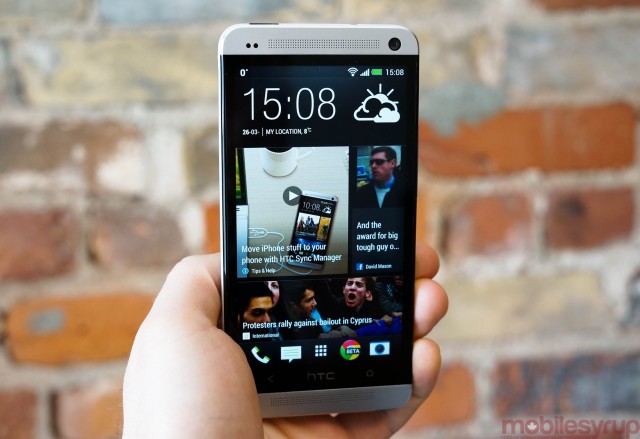
Over the past seven days, I had the privilege of exploring one of the most fascinating and culturally-rich cities in the world. Berlin, from a tourist’s perspective, is full of wide streets, great food, memorable architecture and, yes, a mature cellular infrastructure.
There are three main providers in the country, many of which traverse the continent: O2, T-Mobile and Vodafone. When I left Canada, I was under the impression that it would be relatively easy to bring a compatible unlocked smartphone and obtain a prepaid SIM card without much hassle. It turned out, in fact, to be even easier than I thought, and throughout the ensuing seven days it became clear to me: I could get by, in Canada or any country with a compatible network, on a data-only SIM card.
First, the basics. On Friedrichstraße, one of the city’s main streets for restaurants and shopping, I walked into a well-stocked MVNO by the name of Mobiledirect that re-sold O2 service under the brand FONIC. While the company distributes smartphones and postpaid plans, I was interested in its prepaid fare. I discovered that, in addition to value-conscious voice and text plans, for €20 FONIC sold a 1GB data-only SIM. I brought along an unlocked Rogers HTC One, which happens to be compatible with most of the world’s 3G networks, including Germany’s.
I thought for a while about the ramifications of a data-only SIM. Not travelling with anyone, I didn’t need to make local calls or texts, at least not in any traditional way. Due to the recent proliferation of data-based texting and VoIP apps (Google Hangouts, Kik, WhatsApp, Viber, Skype, Facebook, etc.) there would be no distinction between talking to friends and family back home; no phone numbers are involved at all. With some friends I’d use Facebook Messenger, others Hangouts. For calls, I’d use a mix of Facebook, Skype and Viber.
What’s important here is not that “native” phone calls and SMS services are obsolete but that they can — and increasingly are — being replaced by data-centric equivalents. A VoIP call uses just a few megabytes, and a week’s worth of messages even less.
Recently, a few VoIP services like Fongo and Vonage added the ability to port cellphone numbers over to VoIP services, allowing users to set up the digital equivalent of a traditionally trunk. More a la carte SIP providers, like voip.ms, let you port a number or purchase a new one and route incoming and outgoing phone calls through third-party apps like CounterPath’s excellent multi-platform Bria app, which is available for iPhone and Android.
The main problem with this approach is that all Canadian pre- and postpaid cellphone plans begin with voice and texting as a requisite — data is merely tacked on to the end of the bill. As providers like Rogers, Bell and TELUS have seen users’ data needs skyrocket while traditional calls and texts plummet, they have maintained a clear and incisive revenue path by differentiating based on data bandwidth limits. In other words, you have no choice but to pay for voice and SMS capabilities that you may not want. Even if removing such features would only save a few dollars a month, there is no option to do so.
I acknowledge that it is possible to work around this by purchasing a tablet-specific data plan and using it in a phone, but this brings up another sore spot for Canadians: price. Anywhere in Europe, it’s possible to get reliable, high-speed HSPA+ service for much less than its Canadian equivalent. As providers entice users over to high-speed LTE networks, they could take advantage of increasingly-vacant PCS spectrum used to power HSPA+ networks and offer discounted data services to those who don’t need the extra speed. This would be a boon for visitors looking, as I did in Germany, to connect for a short time with a data allotment sufficient enough for calls, messages, mapping, browsing and the occasional streaming video.
I haven’t delved into the complicated and often divisive world of MVNOs in this piece because the regulations that go along with enforcing competitive wholesale prices is not applicable in the cellular industry. Unlike the ISP side, cellular providers are not required to sell third-party access to their networks at any specific rate. The market sets the price, which means for users of PC Mobility or 7/11 SpeakOut, data prices are often the same or only slightly less than the parent providers themselves. I am not endorsing the regulation of wholesale network pricing, but rather encouraging providers to take advantage of an increasingly-unused section of network to sell lower-cost data-only SIM service.
At its core, the issue is about paying for features you don’t use. One could argue that by differentiating based on data allotment, you’re removing voice and SMS services from the equation. But then, based on incumbent providers’ most recent price plans, you’re paying $70 for 2GB of data, $80 for 4GB and $100 for 6GB. I don’t need voicemail; I don’t need texting, extreme or otherwise. I just need raw data access, plain and simple.
I may be in the minority, but there is a growing subset of users who just want to pay for what they’re using. Nothing more, nothing less.
MobileSyrup may earn a commission from purchases made via our links, which helps fund the journalism we provide free on our website. These links do not influence our editorial content. Support us here.


